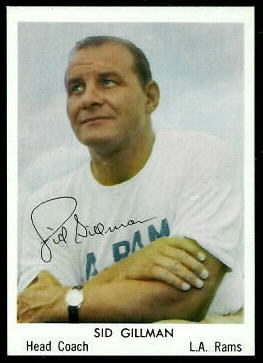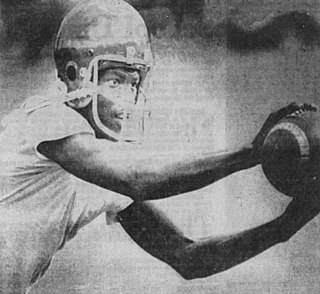Related Research Articles

Sidney Gillman was an American football player, coach and executive. Gillman's insistence on stretching the football field by throwing deep downfield passes, instead of short passes to running backs or wide receivers at the sides of the line of scrimmage, was instrumental in making football into the modern game that it is today.

Ernest Alonzo Nevers, sometimes known by the nickname "Big Dog", was an American football and baseball player and football coach. Widely regarded as one of the best football players in the first half of the 20th century, he played as a fullback and was a triple-threat man known for his talents in running, passing, and kicking. He was inducted with the inaugural classes of inductees into both the College Football Hall of Fame in 1951 and the Pro Football Hall of Fame in 1963. He was also named in 1969 to the NFL 1920s All-Decade Team.

Clyde Douglas "Bulldog" Turner was an American professional football player and coach in the National Football League (NFL). He was elected, as a player, to the College Football Hall of Fame in 1960 and the Pro Football Hall of Fame in 1966. He was also selected in 1969 to the NFL 1940s All-Decade Team.

Daniel John Fortmann was an American professional football player who was a guard and linebacker for the Chicago Bears in the National Football League (NFL). He played college football at Colgate University. Playing for Chicago from 1936 to 1943, he was selected as an All-Pro for seven consecutive years from 1937 to 1943. He was the Bears' team captain starting in 1940 and led the team to NFL championships in 1940, 1941, and 1943.

Peter Louis Pihos was an American football player and coach.

Morris Hiram "Red" Badgro was an American professional football and baseball player. He played as an end in the National Football League (NFL). He was inducted into the Pro Football Hall of Fame in 1981.

Alphonse Emil "Tuffy" Leemans was an American professional football player who was a fullback and halfback who played on both offense and defense for the New York Giants of the National Football League (NFL). He was inducted into the Pro Football Hall of Fame in 1978 and was named in 1969 to the NFL 1930s All-Decade Team.

Bernard W. Bierman was an American college football coach best known for his years as head coach of the Minnesota Golden Gophers football program. Between 1934 and 1941, his Minnesota teams won five national championships and seven Big Ten championships and had four perfect seasons.

George Edward Trafton was an American professional football player and coach, boxer, boxing manager, and gymnasium proprietor. He was inducted into the Pro Football Hall of Fame in 1964 and was also selected in 1969 as the center on the NFL 1920s All-Decade Team.

Joseph Lee Stydahar, sometimes listed as Joseph Leo Stydahar, and sometimes known by the nickname "Jumbo Joe", was an American professional football player and coach. He was inducted into the Pro Football Hall of Fame in 1967 and the College Football Hall of Fame in 1972.

Darrell E. Mudra Sr., nicknamed "Dr. Victory", was an American football coach. He served as the head football coach at Adams State College (1959–1962), North Dakota State University (1963–1965), the University of Arizona (1967–1968), Western Illinois University (1969–1973), Florida State University (1974–1975), Eastern Illinois University (1978–1982), and the University of Northern Iowa (1983–1987), compiling a career college football record of 200–81–4. Mudra was also the head coach of the Montreal Alouettes of the Canadian Football League (CFL) for one season in 1966. He was inducted into the College Football Hall of Fame as a coach in 2000.

John Leo "Paddy" Driscoll was an American professional football and baseball player and football coach. A triple-threat man in football, he was regarded as the best drop kicker and one of the best overall players in the early years of the National Football League (NFL). He was inducted into the Pro Football Hall of Fame in 1965 and the College Football Hall of Fame in 1974.

George Edkin Little was an American football player, and coach of football, basketball, and baseball, and college athletics administrator.

George Floyd Jr. is an American former professional football player who was a defensive back for two seasons with the New York Jets of the National Football League (NFL). Over his NFL career, Floyd appeared in ten games during the Jets' 1982 season, including three playoff games, and eight in their 1984 season, with two games started. Floyd retired after sustaining a knee injury in the 1985 NFL preseason.

Philip Henry Bridenbaugh was an American football player and coach. A graduate of Franklin & Marshall College, where he earned a degree in teaching and spent four years on several of its sports teams, Bridenbaugh coached football at several places in his home state of Pennsylvania prior to being selected as the head coach of the Geneva College Golden Tornadoes in 1917. He left Geneva in 1922 with a 23–12–5 record and took a job with New Castle Junior/Senior High School as a mathematics teacher and head football, basketball, and track and field coach. He did not lose a football game in his first two years, marking the first of eleven undefeated seasons, and, over the course of 33 years, won seven league titles in the sport, leaving in 1955 with a 265–65–25 record. He continued to work as an assistant football coach at Grove City College until 1964 and was inducted into several regional halls of fame. He died in June 1990 at the age of 100.
The Case Western Reserve Spartans football team is the varsity intercollegiate football team representing the Case Western Reserve University, located in Cleveland, Ohio, United States. They compete in the National Collegiate Athletic Association (NCAA) at the Division III level and hold dual membership in both the Presidents' Athletic Conference (PAC) and the University Athletic Association (UAA). They are coached by Greg Debeljak. Home games are played at DiSanto Field. The team in its current form was created in 1970 after the federation of Western Reserve University and Case Institute of Technology.
The 1937 Western Reserve Red Cats football team represented Western Reserve University, now known as Case Western Reserve University, during the 1937 college football seasonThe team was led by third-year head coach Bill Edwards, assisted by Roy A. "Dugan" Miller. Notable players included Frank "Doc" Kelker, Phil Ragazzo, Albie Litwak, Mike Rodak, and Johnny Wilson.
The 1936 Akron Zippers football team was an American football team that represented the University of Akron as an independent during the 1936 college football season. In its first season under head coach Jim Aiken, the team compiled a 6–2–1 record and outscored opponents by a total of 150 to 87. Mike Krino, Bob Bauer, and Ernie Kaufman were the team captains.
The 1936 Bowling Green Falcons football team was an American football team that represented Bowling Green State College in the Ohio Athletic Conference (OAC) during the 1936 college football season. In their second season under head coach Harry Ockerman, the Falcons compiled a 4–2–3 record, finished in 11th place out of 19 teams in the OAC, and outscored opponents by a total of 66 to 60. James Inman was the team captain.
The 1943 Ohio Athletic Conference football season was the season of college football played by the seven member schools of the Ohio Athletic Conference (OAC), commonly referred to as the "Ohio Conference", as part of the 1943 college football season.
References
- ↑ Fame, The Summit County Sports Hall of. "The Summit County Sports Hall of Fame". Archived from the original on December 22, 2015.
- ↑ "WRU Football 1936/37". case.edu. Retrieved 2016-09-02.
- ↑ The Cincinnati Enquirer from Cincinnati, Ohio on December 6, 1936 · Page 38
- ↑ "Falcons Do Well Against Reserve". The Daily Sentinel-Tribune. September 28, 1936. p. 3 – via Newspapers.com.
- ↑ Ken Hartwick (September 27, 1936). "Grid Game Here Won By Western Reserve". The Evening Independent. p. 8 – via Newspapers.com.
- ↑ "Akron Loses to Western Reserve". The Coshocton Tribune. October 4, 1936. p. 11 – via Newspapers.com.
- ↑ "Reserve-Case Game Draws Record Sale". Plain Dealer. November 17, 1936. p. 18 – via NewsBank.